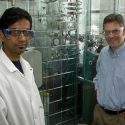New technologies target food-borne illnesses
On its journey to your dinner plate, food is vulnerable to contamination along the way. Usually, it arrives at its final destination without picking up dangerous microbial hitchhikers-but not always.
According to estimates from the U.S. Centers for Disease Control and Prevention, food-borne pathogens account for 76 million illnesses, 325,000 hospitalizations and 5,000 deaths in the United States each year. As the food industry continues to globalize, food safety is expected to remain a significant public health issue.
In 2000, UW–Madison made a commitment to help tackle this complex problem by hiring an interdisciplinary group of researchers with expertise in food safety.
One member of the food safety team now holds patents for two promising devices that harness cold plasma-a state of matter similar to a chemically and electrically reactive gas-to kill food-borne pathogens. The innovative devices are particularly suited for eventual use in industrial settings, such as food-processing plants.
“Plasma technology is a very important process that is applied in industry. It can do many things, things that often conventional chemistry cannot,” says Frank Denes, associate professor of biological systems engineering in the College of Agricultural and Life Sciences.
Denes designed and holds patents on the two devices through the Wisconsin Alumni Research Foundation (WARF).
Plasma is considered the fourth state of matter, along with the more familiar forms: solid, liquid and gas. In a nutshell, a plasma is a gas with free electrons whizzing about. The electrons, accelerated by an electric or electromagnetic field, collide with gas atoms and molecules, fragmenting them to create reactive species, such as ions, free radicals and other excited species.
“Plasma species interact with inorganic and organic materials and change their structure,” says Denes, who is also affiliated with the Food Research Institute, the department of food science and the College of Engineering’s Center for Plasma-Aided Manufacturing.
When only a small fraction of the gas molecules are broken up into ions, or ionized, and the atomic and molecular species have low energies, it is called a cold plasma. By comparison, hot plasma is the stuff of stars-including the sun-and is characterized by a high degree of ionization and very high energy levels.
In the lab, cold plasma is generated by sending an electrical current through a gas. By adjusting the type of gas, the flow of the electrical current and other factors, cold plasma can be manipulated to perform a variety of practical functions, most involving the alteration of surfaces. Cold plasma can be used to etch, oxidize, and deposit thin layers of macromolecular structures on surfaces, among other things. “Most of the plasma research is about surface chemistry,” explains Denes.
Surface chemistry alteration also explains how cold plasma kills bacterial pathogens. As in any living cell, bacteria are enveloped by a protective outer layer that provides structural support and regulates the flow of nutrients and other molecules required for survival. “If you expose bacteria to plasma, you alter the surface of the bacteria and it kills them,” says Denes.
Although cold plasma technology has been used for various manufacturing processes, including microelectronics, since the fluorescent light bulb was designed in the 1930s, Denes’s cold plasma reactors are the first to work at atmospheric pressure.
One device looks like a sandwich-sized block of white ceramic. One side features over 200 circles, arranged in a grid. Each circle houses an electrode, and when the reactor is on, they all work together to produce a constant and uniform flow of plasma. The reactor can be suspended, electrodes pointing downward, above any surface in need of disinfection, such as a moving conveyer belt.
In collaboration with Amy Wong, a microbiologist at the Food Research Institute, Denes says they have found that the plasma treatments reduce some bacteria populations by a factor of 1,000 to 100,000.
The second device decontaminates water and other fluids. The device looks like a large glass jug that holds about 1 liter, fitted with specialized caps that house the electrical gadgetry needed to produce a plasma.
As liquids swirl inside the reactor, cold plasma inactivates the contaminants. Wong found that within 20 seconds, the reactor inactivates high concentrations of bacteria, killing up to 100,000 colony-forming units per milliliter of liquid.
With their increased ease of use and effective disinfection capabilities, the new atmospheric-pressure cold plasma reactors may end up playing an important role in the delivery of safe food products to dinner plates around the world, Denes says.
Tags: biosciences, research



